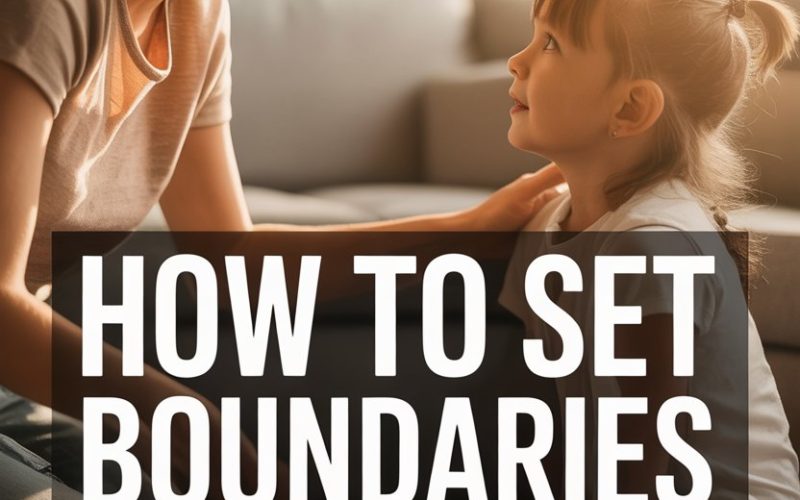Every parent has had that moment: your child is scaling the back of the sofa for the umpteenth time, and you can feel your voice rising somewhere between “Please get down!” and full-on banshee.
If only there were a way to draw the line without feeling like a drill sergeant (or losing your mind).
The good news? Clear, calm boundaries aren’t just for saintly television supernannies. You can do this—even after a long day and a lukewarm cuppa that’s been microwaved twice.
Clarity is Kindness
Kids are natural detectives when it comes to boundary testing. They sniff out vagueness like a bloodhound on a scent. “Maybe later” and “We’ll see” translate to “Badger until victory” in kid-speak.
Swap out soft, squishy phrases for clear, simple statements. “We keep feet on the floor” leaves little room for interpretation (or Olympic couch vaulting).
The trick: state your expectation as if you expect it to happen. Firm, cheerful, and not an ounce of doubt.
Backing yourself up with a reason—when time allows—sweetens the deal. “We keep feet on the floor so the sofa doesn’t break and we don’t get hurt.”
Research in child development circles suggests that explanations, paired with clear limits, help kids internalise boundaries over time.
Consistency Leads the Way
Cue the collective parental groan: consistency is hard. Life is chaotic, and sometimes “no TV before dinner” slips into “Fine, watch Bluey, just let me finish this work call.” Nobody’s keeping score.
But when boundaries flip-flop, your child gets the message that the rules are up for negotiation depending on the wind direction.
Pick the boundaries that matter most to your family—safety, respect, screen time, bedtime, whatever your household needs to keep ticking. Stick to these, even when the going gets tough.
When your child knows what to expect, there’s less room for meltdowns (from either party).
A helpful trick: think of your boundaries like the edge of a swimming pool. Kids feel safer knowing where the deep water starts, even if they grumble about it.
Catch Them Being Good
Setting boundaries isn’t just about saying “no.” It’s about noticing when your child is making good choices. “I saw you put your dishes in the sink without a reminder—thank you!” is worth its weight in gold stars.
Children (and adults, let’s be honest) are more likely to stick to rules when they feel noticed for their efforts. Positive reinforcement isn’t new, but it’s powerful.
Praise works best when it’s specific and genuine.
A wink, a high-five, or a whispered “Nice job!” can help reinforce the behaviours you want to see. The quieter the recognition, the more it feels like a secret superhero handshake between you and your child.
Stay Calm, Even When They’re Not
Let’s get real: Kids have a sixth sense for when you’re running on fumes. They pick that exact moment to go full Tasmanian devil.
Staying calm when your child is losing it? Easier said than done. But it’s the golden ticket for keeping boundaries intact.
Try lowering your voice instead of raising it. Kids are hardwired to pay closer attention to a quiet, serious tone. It’s the parenting equivalent of a Jedi mind trick.
If you feel the pressure cooker reaching boiling point, it’s okay to pause. “I need a minute to calm down before we talk about this.”
Not only are you modelling emotional regulation, but you’re also hitting the boundary reset button for both of you. (Pro tip: deep breaths aren’t just for the kids.)
Offer Choices Within Limits
Nobody likes feeling bossed around 24/7. Kids especially. Giving your child some say within your boundary can work wonders. It’s the parenting version of “You can’t stop the rain, but you can choose your umbrella.”
Instead of “Brush your teeth now,” try, “Do you want to use the blue or the green toothbrush?”
Both options get you where you need to go, but your child feels a sliver of control. Magically, cooperation often follows.
The trick is offering choices you’re genuinely okay with. Don’t say “Carrots or ice cream for snack?” unless you’re ready to see Rocky Road on the dinner plate.
Use Natural and Logical Consequences
Ever told your child, “If you don’t put your shoes on, you can’t go to the park”—and then caved anyway? Natural consequences let the world do the teaching (within reason and safety). Logical consequences step in when the world needs a hand.
If your child refuses to wear a raincoat, a quick drenching from stepping outside often does the trick. When paint ends up on the walls, handing over a damp cloth and inviting them to help clean up connects the dots better than a lecture.
Psychologists like Dr. Laura Markham recommend logical consequences over punishments because they teach the “why” behind the boundary, not just “because I said so.”
Reserve consequences for the non-negotiables, and keep them as immediate, related, and fair as possible. Threats that never materialise just weaken your position—you know your child will call that bluff.
Stick to Your Guns—But Show Empathy
Boundaries aren’t brick walls. Your child needs to know the line is there, but also that you understand their feelings about it. “I know it’s hard to leave the playground when you’re having fun. I wish we could stay too.”
Naming your child’s feelings doesn’t mean caving. It does help them feel seen and heard, which can take the sting out of disappointment. Think of empathy as the soft pillow cushioning the edge of your boundary.
If you grew up in a “because I said so” household, this can feel unnatural at first. Keep at it. Kids who feel understood are more likely to cooperate—and less likely to go nuclear.
Set Yourself Up for Success
Ever notice how your child melts down right when you’re out of snacks, patience, and Wi-Fi? Sometimes, the best boundaries are the ones you set before things go sideways.
Structure helps. Regular routines around meals, sleep, play, and transitions provide a sense of security. When your child knows what to expect, there’s less pushback.
A little preparation goes a long way. “We’re leaving the park in five minutes. Do you want to go on the slide or the swings one last time?” Cue card, curtain call, exit stage left (with marginally less drama).
Repair and Reset After Slip-Ups
Every parent has lost their cool at some point. Yelling happens. The trick isn’t to aim for perfection, but to repair and reset when things go off the rails.
A simple apology—“I was really frustrated and I yelled. That wasn’t okay. Next time I’ll try to use my calm voice.”—teaches more about boundaries than a week of stone-faced discipline.
You’re showing your child that everyone makes mistakes and that repairing relationships is what matters most.
Kids are resilient. When you own your moments, they learn to own theirs. That’s a parenting win.
Keep Your Expectations Age-Appropriate
Expecting your toddler to share their favourite toy for thirty minutes while you have a cuppa is…optimistic. Boundaries work best when they match your child’s developmental stage.
Young children need boundaries as basic as “Don’t run into the road.” Older kids can handle more nuanced limits, like “Phones stay in the basket during dinner.”
Adjust your approach as your child grows, and cut everyone some slack (yourself included) when things wobble.
A bit of research, such as this study from the University of Washington, shows that children’s ability to understand and respect boundaries grows over time—especially with patient, consistent guidance.
Pick Your Battles (Without Guilt)
Not every hill is worth dying on. If mismatched socks and questionable fashion choices keep the peace on a school morning, perhaps that’s a win.
Save your energy for the big stuff—safety, kindness, sleep, respect.
It’s not giving in; it’s smart triage. Even the best boundaries have to bend sometimes. Just don’t let the important ones snap.
Why Boundaries Without Yelling Matter
There’s no badge for the parent who never raises their voice (if there were, it would be made of chocolate and gone by dinnertime).
But modelling how to set limits calmly sets your child up for healthier relationships, better self-control, and a stronger sense of security.
It’s not about perfection—it’s about progress. Every calm boundary, every patient explanation, every repair after a tough moment, adds up.
The Next Time You Feel the Volume Rising
Setting boundaries without shouting isn’t just possible—it’s within reach.
Arm yourself with clarity, consistency, empathy, and a side of humour, and you’ll make it through the trickiest of tantrums with your dignity (and your child’s trust) intact.
And remember, you’re not alone in this. Thousands of parents are tiptoeing around Lego on the floor, trying not to step on a scream.
Turns out, you’re doing just fine.





